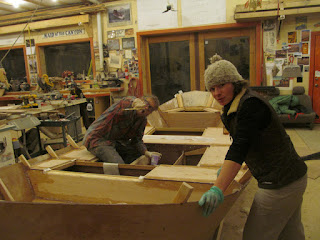I spent most of today figuring out and building 1) the layout of the side hatch lids, and 2) the obscure guttering for the hatches.
The first project involved finding the hinge point for the side hatches such that when the lid is open, a boatman could still row; then figuring out how low the inside edge of the hatch should drop in order for the oar, when pushed down on the deck, would parallel the tilt of the hatch lid. Did that make sense? Maybe you had to be there. Anyhow. I think I found the ideal hinge point and hatch angle.
The guttering is a bit more complex to figure out, and even trickier to cut into the framing, as a lot of the channels end mid-board, so they cannot be ripped in on the table saw. So I am using the Dewalt circular saw and a chisel. So far so good. Might throw my mini-router into the mix of tools tomorrow.
I've been meaning to introduce the new shop tool I got last fall. I got mighty sick and tired of trying to get some sort of accurate adjustment out of my flimsy router table and ancient Sears router. So I went ahead and invested in a Grizzly shaper. Wow, what a great tool. Very easy to adjust precisely, a rich whir instead of an ear-splitting scream, and quite affordable. I think the additional money that I will spend on big bits will be more than saved on their strength and longevity. Not to mention saving me from more tantrums. I put a few featherboards on it to keep things running tight and true without having to resort to a big feeder apparatus.

This evening I mixed up a big batch of my latest rendition of boat soup / LTV / oil-stain: A very nice varnish (Pettit Flagship), a good boiled linseed oil, a nice--if expensive--aromatic balsam turpentine, and some really nice kiln-burnt pine tar. The latter two ingredients are from American Rope and Tar, and oh my god do they smell nice. Definitely worth the price if you like that kind of shit. And I got to thinking as I saturated the the understory of the boat, that these boats I so enjoy building should not just perform nicely and look lovely--they should also feel nice to the touch, sound sweet and solid when you thump them, and... they should even smell delicious. Those of us that had the joy of rowing original Briggs dories in Grand Canyon in the '70s and '80s are still brought nearly to tears by the nostalgic smell of the Port Orford Cedar that the boats were framed in and which permeated their hatches. And which I use today not only for its fine woodworking qualities, limberness, and decay resistance, but for its wonderful odor.
The hatches of the
Rio Rojo will start out with a distinct odor of turp and pine tar, and as years go by, come to be more dominated by the Port Orford. What fun to think about.
Now... how to make the boat taste good.



















































